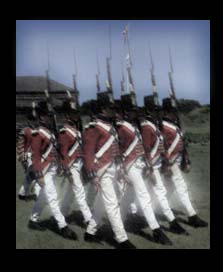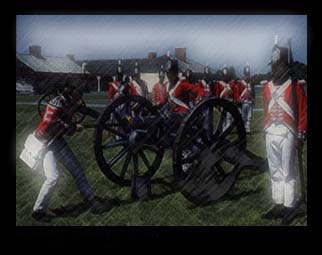Article Index
Page 1 of 6

Update: August 29th, 1999
This was recently submitted by a reader...
This was recently submitted by a reader...
I was a cadet for three years starting in 1996 and every year we would have a sleep over party at the Old Fort York.
One time we saw a strange women looking like she wanted to take my friends hand. Needless to say, we sat up in bed and we screamed as she tried to come toward us.
After that we have never saw a women in the place again which was a blessing as I was scared to death!

Update: This is from our Message board from April of 2000...
If you believe that ghosts/spirits/what have you are most active on important anniversaries, then mark on your calendar April 27th if you live in or near Toronto.
This will be the 187th anniversary of the American attack on York (Toronto).
The American forces landed with initially no opposition (a poor call by the British command as it allowed the American's established a beachhead,) around present day Sunnyside Beach (oddly enough, there is a historical plaque just North of the gates (at the CNE grounds) denoting the location of the landing on the West side of Dufferin St. South of King St.,) and were initially met by an attack force mostly made up of Grenadiers from King's 8th as well as a mixed bag of Newfoundland Fencibles (a British regular army outfit from (obviously,) Newfoundland,) and members of First Nation's tribes.
Of the 119 Grenadiers who were sent out, only 30 survived. (See our story on Grenadier Pond for a possible related story.) The Grenadier's and Fencibles were not trained to fight a "bush" battle but a set-piece European battle of standing shoulder to shoulder firing in platoons so the American's simply hid behind stumps and trees and picked off these brave if ill-used souls. (Before anyone thinks this "set piece" tactic poor, try having a war using the "Brown Bess" musket. A terrible and inaccurate weapon which is best used en masse in a quick burst of fire. If you study other battles, this "platoon" firing literally scared the militias of both sides into retreat on many occasions! American regulars (full time) soldiers ALSO used firing by platoon during the battles of 1812-1814.)
The next horrible carnage was caused by an accidental powder explosion at the Western Battery (located just West of the current fort,) when a gunners match lit a wooden magazine box loaded with powder and cartridges. This explosion killed, maimed and literally roasted many of the militia stationed within. Those who had survived then withdraw to the fort only to be caught in another dreadful explosion.
The British regulars, sensing the American victory, withdrew to the East and as they left, blew up the main powder magazine within Fort York to keep it from falling into American hands. The American general leading the attack, Zebulon Pike, was crushed to death by a rock launched up by this explosion. Although some of the Canadian defenders left behind knew the magazine was going to blow, the immense impact was not known and many of these defenders also died in the explosion.
So many men killed by musket fire, cannon shot and, of course, falling debris from the massive explosion would of course not only leave a mark in our history books but likely have lead to more than a few good "ghosts".
The Union Flag (Note: Did you know it is NOT a "Union Jack" unless flying on a ship? The British flag on land is properly known as The Union Flag... Useless fact #1263.) was lowered and the Stars and Stripes raised. The British flag was used to cushion the head of the dying General Pike as the American's finally had succeeded in taking York.
By the end of the battle, hundreds of men from all sides lay dead and dying around the fort and the Western lead up to it.
The real purpose of the American attack was to burn or capture the "General Brock", a warship being built in Toronto Harbour and to capture "public stores" for their own use. Engaging and capturing the badly outnumbered British regulars that were stationed there was also a goal but Major General Sheaff not only managed to retire the force of regulars to Kingston but also burned the "General Brock" en route thus denying some of the most important goals of the attack. Not only this but the American's only occupied York until May 1st and then left after looting the town (although, the did return twice... Once successfully and once the batteries at Gibraltar Point (Toronto Islands) and the fort managed to beat back the approaching American vessels), firing the parliament buildings and being constantly berated by a cleric (Rev. Dr. John Strachan). One wonders, had they HELD York, how long could the Niagara area have held out without a land link to Montreal or Kingston? Would Southern Ontario be a US state now???
Therefore, it seems poor Zebulon Pike and so many other brave souls died for not much of anything.
Oddly enough, although Sheaff did thwart the grand American plans by his removing the British regulars and firing the "General Brock", he was shunned in York as a commander who allowed the town to fall into the hands of the enemy and left the militia (citizen soldiers) to fend for themselves. The Rev. John Strachan (the thorn in the American's backside during the occupation,) made darn sure that the British command knew of this "disgraceful" situation and Sheaff was relieved of command shortly thereafter.
As far as the war goes in Toronto, this is the worst episode for loss of life and IF there are ghosts from that era wandering the ramparts of Fort York, this is likely When they came from.
Fort York is open on April 27th and has special events planned to commemorate this tragic event. If you believe anniversaries are important, this is the day to visit Old Fort York and to stroll along the avenues around it and absorb a bit of history.





